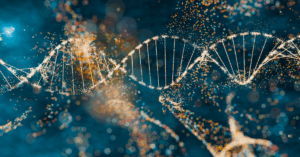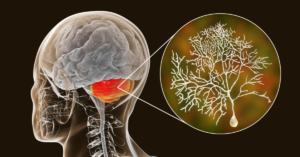
Written by: Sophia Salemi, BS
Edited by: Celeste Suart, PhD
Article highlight: Scientists have discovered that changes in the POU4F1 gene can cause a very rare hereditary ataxia syndrome with first symptoms beginning in childhood. A new patient registry is now open, giving families the opportunity to join a growing community and help researchers better understand this condition.
Researchers are continuing to discover new genetic causes of hereditary ataxia, conditions that affect balance and coordination, many of which are extremely rare. One such discovery involves the POU4F1 gene.
In 2021, Dr. Bryn Webb, Associate Professor at the University of Wisconsin School of Medicine and Public Health, and her colleagues used whole-exome sequencing (a form of advanced genetic testing) to study individuals with unexplained neurological symptoms. They identified POU4F1 gene changes in four unrelated people, all of whom shared strikingly similar clinical features (Webb et al., 2021).
Using whole-exome sequencing, Dr. Bryn Webb, Associate Professor at the University of Wisconsin School of Medicine and Public Health, and colleagues identified heterozygous (single-copy) loss-of-function variants in the POU4F1 gene in four unrelated individuals presenting with similar neurological symptoms in 2021. So far, these are the only known reported cases worldwide. Dr. Webb’s team, working closely with the newly formed POU4F1 Patient Foundation, is now connecting with more families and learning from their experiences.
The POU4F1 gene provides instructions for making a protein called a transcription factor. This protein helps control the activity of other genes during brain development, especially in regions responsible for balance and coordination.
When there are changes (mutations) in this gene, it can lead to symptoms such as:
- Problems with balance and coordination (ataxia)
- Shaking of the hands when reaching for objects (intention tremor)
- Low muscle tone (hypotonia)
- Occasional brief episodes of the eyes rolling upwards (paroxysmal tonic upgaze)
In addition, brain scans show that persons with this disorder may have a smaller cerebellum than typical. The cerebellum is the part of the brain that helps controls balance and movement. Some also experience developmental delays, meaning milestones like walking, talking, or speaking may occur later than typical.
Building a POU4F1-related Ataxia Patient Registry
To better understand this ultra-rare condition, the Webb Lab has partnered with the POU4F1 Patient Foundation to create a comprehensive patient registry.
The registry will help researchers learn:
- The full range of POU4F1-related symptoms
- How symptoms change over time
- How the condition varies between individuals
This registry will help to connect families with one another, promote data sharing amongst researchers, and lay the groundwork for future clinical trials and potential treatments. “Our goal is to bring families together, learn from their experiences, and create a resource that empowers both researchers and patients,” says Sophia Salemi, BS, research specialist in the Webb lab. “Every family’s story helps us better understand this rare condition and brings us closer to improving care and finding targeted treatments.”
Why This Discovery Matters
The discovery of POU4F1-related ataxia adds to our growing understanding of the genetic factors underlying hereditary movement disorders. The identification of this disorder shows how important transcription factors are in controlling how the brain develops and maintains coordination and balance. This discovery also opens the door to deeper mechanistic studies, development of laboratory models, and ultimately, targeted therapies.
How To Get Involved
If you or a loved one has a confirmed POU4F1 gene change and would like to join the POU4F1 Patient Registry, please fill out this form. Participation will help improve understanding of this disorder and connect you with other families, if interested, in the POU4F1-related ataxia community.
Key Words
Transcription factor: A special type of protein that turns other genes “on” or “off”. By regulating other genes, transcription factors play a crucial role in the development and function of tissues, including the nervous system.
Patient registry: A secure database where researchers collect information from people affected by a specific condition to improve understanding and advance treatments.
Conflict of Interest Statement
The author, Sophia Salemi is a clinical research coordinator and research specialist for the Webb Lab. She has contributed to the lab’s cellular modeling of POU4F1-related ataxia and currently manages the patient registry. She consents patients and works closely with the POU4F1 Patient Foundation as a scientific advisor. Celeste Suart declares no conflict of interest.
Citation of Article Reviewed
Webb, B. D., Evans, A., Naidich, T. P., M Bird, L., Parikh, S., Fernandez Garcia, M., Henderson, L. B., Millan, F., Si, Y., Brennand, K. J., Hung, P., Rucker, J. C., Wheeler, P. G., & Schadt, E. E. (2021). Haploinsufficiency of POU4F1 causes an ataxia syndrome with hypotonia and intention tremor. Human mutation, 42(6), 685–693. https://doi.org/10.1002/humu.24201
Read Other SCAsource Summary Articles

Discovery of a Novel Ultra-Rare Hereditary Ataxia Syndrome Caused by Changes in the POU4F1 Gene
Written by: Sophia Salemi, BS Edited by: Celeste Suart, PhD Article highlight: Scientists have discovered that changes in the POU4F1 gene can cause a very rare hereditary ataxia syndrome with first Read More…

Oligonucleotídeos Antissenso para a Ataxina-3 Mutante pode Melhorar a Disfunção dos Neurônios de Purkinje
Escrito por: Asmer Aliyeva Editado por: Dr. Hannah K Shorrock Traduzido por: Priscila Pereira Sena Tratamento com Oligonucleotídeo Antisenso (ASO, do inglês Antisense Oligonucleotide) melhora a função dos neurônios de Purkinje regulada Read More…

Running on Empty: Understanding how fatigue affects quality of life in Spinocerebellar ataxias
Written by Alexandra Putka Edited by Dr. Pragya Goel Feeling tired? You’re not alone. Fatigue is a common symptom of Spinocerebellar ataxias and affects quality of life. Spinocerebellar ataxias (SCAs) Read More…



